List of Authors
>>About this blog
Recent blog post
|
[CAM]
May 30, 2015 09:00
The current Chuo-ku was formed in 1947 by the integration of the former Nihonbashi Ward and the former Kyobashi Ward, but the Nihonbashi Ward and Kyobashi Ward were established in 1878. It seems that the planner at that time considered the names "Beijiang To-ku" and "Minamiedo-ku". In other words, it seems that the idea was to consider the area of both Nihonbashi and Kyobashi wards as "Edo" and divide it into north and south into two wards. At the time of the establishment of Chuo-ku in 1947 (the integration of both wards), it seems that there was a plan to name "Edo-ku" or "Oedo-ku".
This reminds me of the background that the name of the subway and Toei "Oedo Line" was decided. At the end of November 2000, as a result of the public offering, "Tokyo Loop Line" was nominated as the first candidate, but at that time, Tokyo Governor Shintaro Ishihara said, "The ring line will return to the same place no matter how many times it turns," and "The majority of the votes confusing with the Yamanote Line (JR East) or the Osaka Loop Line (JR West Japan) was selected. Initially, the committee argued that Shinjuku was not appropriate because it was outside the area of Edo, but the Transportation Bureau said that it was geographical and economical by running around the route and adding a "large" It persuaded the committee to express the cultural spread and came to the decision.
From now on, I feel that the name of this ward may have been better around Oedo Ward than inorganic and monthly names such as "Chuo-ku".
"Chuo-ku" seems to be located in Osaka, Kobe, Sapporo, Niigata, Fukuoka, Chiba, Kumamoto and Sagamihara in addition to Tokyo.
[CAM]
May 27, 2015 18:00
I went to Harumi Wharf to see "Tokyo Minato matsuri".
The construction of Ring Route 2 is also progressing.
The area between Toranomon and Shimbashi was opened in March 2014, but in March 2016, the area between Shimbashi and Toyosu will be connected and will be fully opened.
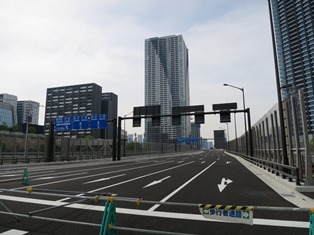
Harumi's landfill was completed in April 1929 as Tsukishima No. 4 (Tokyo Bay Landfill No. 4), but was scheduled to be held in 1940 (1940, Koki 2600). The purpose is to make it the main venue, and the Kachidokibashi was also built accordingly. A commemorative plate has been set up on the site of the Expo Secretariat.
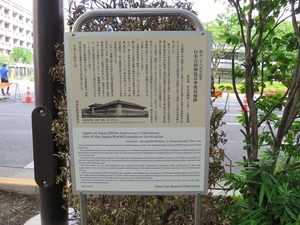
At the Tokyo Minato matsuri, the survey boat marine (Japan Coast Guard), the dredging boat marine dragon (Tokyo Port and Harbor Bureau), the training boat Kaitakamaru (Tokyo University of Marine Science and Technology), and the escort ship Yugiri (Marine Self Defense Force) were also open to the public.
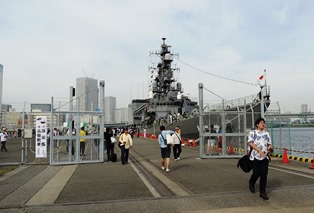
[Kra-san]
May 23, 2015 18:00
Sugimori Shrine is said to have been prayed for victory in Tenkei 3 (940) by Fujita Tahara (later Hidesato Fujiwara) for the rebellion of Taira no Masakado.
In 1466, Michio Ota begged for rain, moved to Inariyama Gosha Ogami, Yamashiro Kuni, religious service, and worshiped Ebisu Oga during the Edo period.
It was counted as one of the Mimori (Sugimori, Yanagimori, Kasumori) under Edo Castle and was called Sugimori Inari. It has an old history dating back to 1084 in 2015.
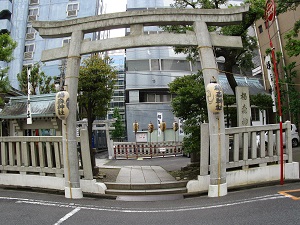 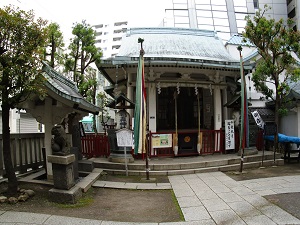
The Reitaisai festival takes place in May, and once every three years, the shrine's large portable shrine cruises around shrine parishioner. This year's main festival was held with the evening palace on the 15th, the Great carrying of miniature shrines on the 16th, and the Children's carrying of miniature shrines and Children's fair on the 17th.
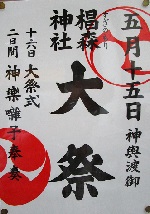 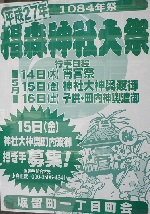 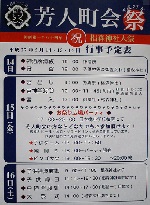
On the 16th, he left the Great portable shrine for the first time in three years, and officers gathered at each town council to take commemorative photos, and the ceremony began at 9:00 am.
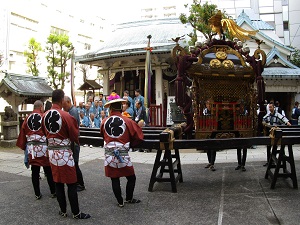
Later, while the music was played in Kagura Hall, the shrine Oga with a total of 30 kan (1.4t) became a shrine.
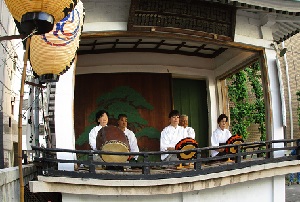
portable shrine traveled all over the shrine parishioner area to the sacred wine area of Ningyocho (Ningyocho 1-chome Yoshitocho, Ningyocho 3-chome Nishicho, Horidomecho 1-chome town association) and returned to the shrine around 5 o'clock in the evening.
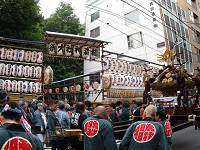 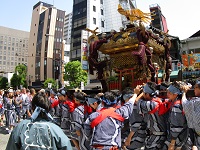
 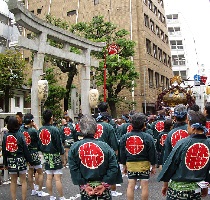
"Sugimori Shrine Annual Festival" was a major event filled with the history and culture of Shitamachi, which celebrated its 1084 festival this year.
[CAM]
May 20, 2015 09:00
I studied a little bit about the history of Chuo-ku, Tokyo, and learned that when the former Nihonbashi-ku and the former Kyobashi-ku were integrated in 1947, the former Nihonbashi-ku, which surpasses history and tradition, showed a sense of resistance to the integration with the new Kyobashi-ku, and I felt a great sympathy about the feelings of Nihonbashi-ko.
According to various materials, in Nihonbashi Ward, before the war, especially before the Great Kanto Earthquake, both husbands and servants live together, and husbands line up desks at local elementary schools, etc. You seem to have a close sense of unity in the region. It seems that the son-in-law was customary, and it seems that a community similar to "Semba" in Osaka was formed.
More than 10 years before the birth of Chuo-ku, Tokyo, Junichirou Tanizaki, who was born and raised in Nihonbashi, said, "The worst thing about the reconstruction of Nihonbashi after the Great Kanto Earthquake is the fate of Nihonbashi children. The traces of their homes are included in the sphere of influence in Kyobashi Ginza Marunouchi ... "("Omofu Tokyo" and "Chuo Koron" from January to April 1997).
In addition, Isamu Yoshii (1886-1960)
I think sorrowfulness of Nihonbashi in my own way ("until yesterday")
I'm singing. Isamu Yoshii doesn't seem to be born or raised in Nihonbashi like Tanizaki, but it seems that he wrote a lot of songs around Nihonbashi and Nihonbashi. And later (1938), I moved to Kansai (Kyoto). In Kansai, it seems that there was a friendship with Tanizaki and Jun Kawada. I misunderstood Isamu Yoshii as a Kansai person from the famous song, "When I sleep in the crab, Gion goes down on the pillow." It seems that the Earl came out, but he has dropped out of the prefectural government. Did the above song compare the setbacks of your life to the subsidence of the power of the Nihonbashi area? "Until yesterday" was published in 1913.
[Akira Makibuchi / Sharakusai]
May 18, 2015 09:00
There is an old main pillar next to Takahashi over the Kamejima River. "Takahashi" is an old bridge that is also described in the early Edo period pictorial drawings, and is said to have passed when Akaho Nanji was repatriated. Recently, mooring and storage facilities for small ships have been established nearby, and the waterside has been improved. I would like to take a look at the history of Takahashi.
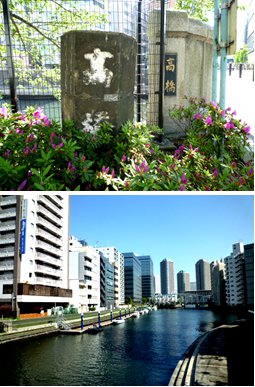 The current "Takahashi" opened in March 1984 (1984) and spans the Kajibashi Street connecting Hatchobori and Shinkawa on the Kamejima River. The downstream from here flows through Minami Takahashi to the Sumida River. The remaining main pillar is located at Takahashi Southeast Children's Amusement Park on the Shinkawa side. This seems to be from a concrete arch bridge that was replaced in 1919 (1919). (Upper photo: The left is the old bridge, and the right is the main pillar of the current bridge.) The current "Takahashi" opened in March 1984 (1984) and spans the Kajibashi Street connecting Hatchobori and Shinkawa on the Kamejima River. The downstream from here flows through Minami Takahashi to the Sumida River. The remaining main pillar is located at Takahashi Southeast Children's Amusement Park on the Shinkawa side. This seems to be from a concrete arch bridge that was replaced in 1919 (1919). (Upper photo: The left is the old bridge, and the right is the main pillar of the current bridge.)
"It is described as a name bridge in the Masayasu Edo Map, which is considered to be a figure from 1644 (1644) to July of the following year (1645). In addition, the origin of the name is said to be derived from the frequent entry and exit of ships because it was built near the mouth of the Kamejima River, and a bridge with a high pier was built." ("Chuo-ku Bridge / Hashizume Square" Chuo-ku Modern Bridge Survey (Chuo-ku Board of Education, 1998)).
During the Edo period, Takahashi was the bridge at the lowermost stream of the Kamejima River, and from Edo Minato to Inari Bridge was at Funairi to Hatchobori (Horiwari), where large ships could only enter this far. The scenery is depicted in "Hundred Views of Edo" and "Tetsubosu Inaribashi Minato Shrine" (Hiroshige). The Shinkawa side was on the banks of the Shogen River.
In addition, "The iron foil truss bridge completed in October 1882 (1882) was the first domestic bridge designed by Japanese engineer Haraguchi Kaname" (same book), and this landscape is Yasuji Inoue's painting "The view of Rei Kishijima Takahashi" depicts a black-painted truss bridge.
Currently, the Kamejima River mooring storage facility managed by the Tokyo Metropolitan Park Association has been set up in the water area between Takahashi and Minami Takahashi so that about 10 ships can be moored (lower photo: Shinkawa side on the left bank seen from Takahashi, and the right bank is Hatchobori Funairi). @ Akira Makibuchi
[CAM]
May 16, 2015 09:00
It would be interesting to examine the process up to the establishment of "Chuo-ku". "Chuo-ku" was formed by the integration of "Nihonbashi-ku" and "Kyobashi-ku" in 1947, but at this time, the Kyobashi-ku assembly immediately voted to integrate, but in Nihonbashi-ku It seems that the Tokyo Metropolitan Government continued to take a cautious stance from the intent of maintaining the traditional Nihonbashi common living area until midnight.
As a result, the integration was passed by one vote, but in connection with the new ward name, "The name of the town in the area of the current Nihonbashi ward is what Nihonbashi, Chuo-ku, what town, what number, and what number?" Was attached.
Regarding the selection of the new ward name, in addition to Chuo-ku, there were plans such as "Edo, Ginza, Oedo, Nikkei". .
|
Links
|












 The current "Takahashi" opened in March 1984 (1984) and spans the Kajibashi Street connecting Hatchobori and Shinkawa on the Kamejima River. The downstream from here flows through Minami Takahashi to the Sumida River. The remaining main pillar is located at Takahashi Southeast Children's Amusement Park on the Shinkawa side. This seems to be from a concrete arch bridge that was replaced in 1919 (1919). (Upper photo: The left is the old bridge, and the right is the main pillar of the current bridge.)
The current "Takahashi" opened in March 1984 (1984) and spans the Kajibashi Street connecting Hatchobori and Shinkawa on the Kamejima River. The downstream from here flows through Minami Takahashi to the Sumida River. The remaining main pillar is located at Takahashi Southeast Children's Amusement Park on the Shinkawa side. This seems to be from a concrete arch bridge that was replaced in 1919 (1919). (Upper photo: The left is the old bridge, and the right is the main pillar of the current bridge.)
